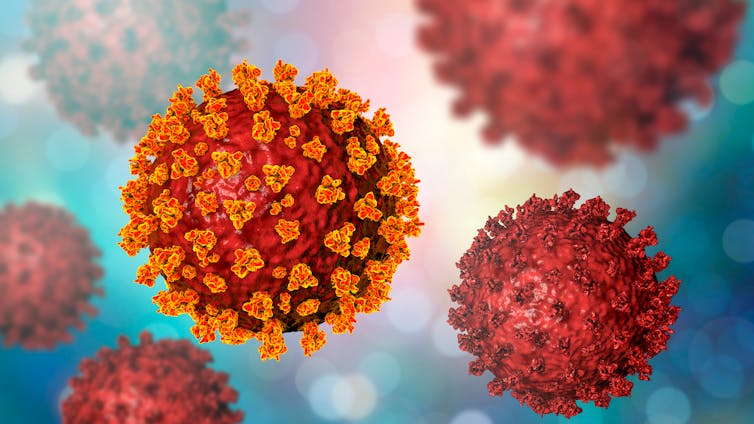A new study suggests coronavirus antibodies fade over time – but how concerned should we be?
suggests that levels of antibodies against the coronavirus have declined across the UK population since testing began. Having randomly sampled 365,000 people across the country, the React2 study – which is yet to be peer reviewed – estimates that 6% of the UK population had antibodies against the virus in late June, but that this had fallen to 4.4% by September.
If antibodies fade over time, how worried should we be? Does this mean we cannot be immune to COVID-19? To answer this question, we need first to consider what antibodies are and what they can tell us about immunity.
When we are infected, our immune system quickly responds to try and contain the threat and minimise the damage infection causes. This initial stage of immune reactivity is covered by immune cells known as innate cells that are resident in our tissues, which use a range of fairly generic strategies to both recognise and kill off the infection. But to truly deal with an infectious challenge, we need another part of our immune system – our lymphocytes.
Lymphocytes are more flexible cells that are “educated” to recognise and target a specific infectious agent. They come in – B lymphocytes, which make antibodies, and T lymphocytes, which can help the B cell response or directly kill the germs. Crucially, T and B lymphocytes work together to eradicate an infection.
Once a threat has been managed, a pool of these educated lymphocytes that know how to deal with that specific germ survive. These are known as memory cells. Memory cells are remarkably long-lived, patrolling our body ready for when they might again be needed. This whole system of lymphocyte responses is known as our adaptive immune response, and antibodies are only a portion of it.
So to properly understand and measure immunity after an infection, you would ideally assess both T and B lymphocytes and then see what happens when people face the same infection. But while testing for these cells is possible, it is expensive and impractical in large numbers of people, requiring costly reagents and detailed testing protocols.
As antibodies can be readily measured in blood samples, they are often used instead as an indication of whether there has been a good adaptive immune response. Over time, though, the levels of antibodies in our blood naturally fall – but this doesn’t necessarily mean protection is lost. Some of those educated memory cells should remain, including memory B cells that can quickly make more antibodies if needed. So the findings from React2 don’t necessarily mean that people are losing immunity to COVID-19.
For instance, have also looked at T cells and found in patients who have recovered from mild and severe COVID-19. We can therefore be somewhat optimistic that we could have some lasting protection against this disease.
We can also look at other viruses for clues. COVID-19 is caused by a beta coronavirus. There are several beta coronaviruses common in the human population – those that are most familiar cause the common cold. Long-lasting immunity to these cold-causing viruses , but immunity to more serious conditions caused by other beta coronaviruses – Mers and Sars – is . We do not yet know if immunity to the virus causing COVID-19 will be more akin to Sars or the cold-causing viruses, but the potential for longer lasting immunity to Sars and Mers offers some hope.
Finally, the React2 study looks at what happens after natural infections, but we should keep in mind that immunity generated by a vaccine might not be the same. Lymphocytes recognise germs by selecting some of their unique features to remember and react to and this matching process can be influenced by many factors, such as how the features are presented to lymphocytes or the available lymphocytes that recognise that feature. Although this allows for massive flexibility in the germs that can be recognised, it might not always result in the best viral killing in the future.
But with a vaccine, you can instead select the best bits of the pathogen to target in order to provoke the most effective T and B lymphocyte responses, which could in turn provoke bigger and better memory responses. This is being factored into the , with several vaccine candidates already being shown to promote .
 Some vaccines are focusing the immune system on targeting the coronavirus’s spike proteins, shown here in orange.
Some vaccines are focusing the immune system on targeting the coronavirus’s spike proteins, shown here in orange.
However, if there is longer lasting immunity, it may not be present across all groups of people. Some, such as the elderly, are disproportionately affected by COVID-19, and the React2 study showed that older people had a . These results may be explained by the fact that many older people have – including the B lymphocytes needed for antibody protection.
Such findings emphasise the need to look at diverse groups of people to fully understand if immunity to COVID-19 is possible, particularly when developing vaccines. This is exactly what is being assessed in the happening now. Right now, we shouldn’t be overly worried. COVID-19 is a giant puzzle we are gradually unlocking. Every piece of the puzzle we master contributes to our growing knowledge and ability to beat this infection.![]()
, Professor in Biomedical Sciences,
This article is republished from under a Creative Commons license. Read the .